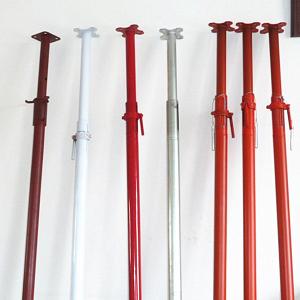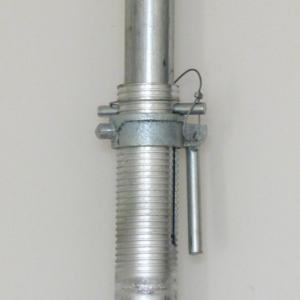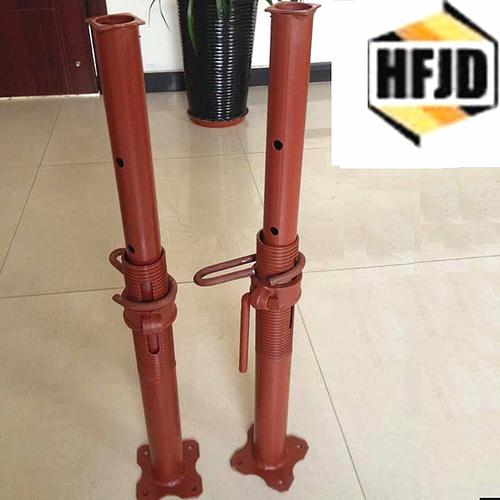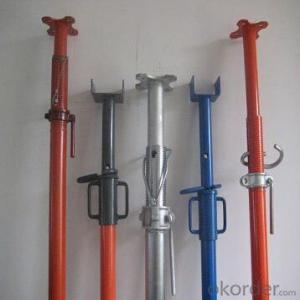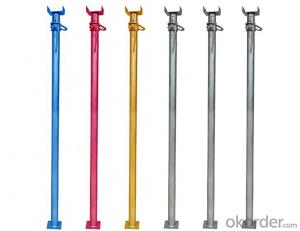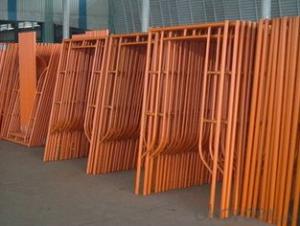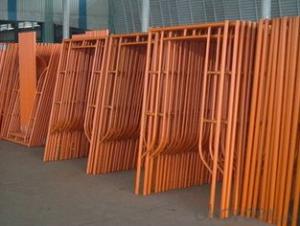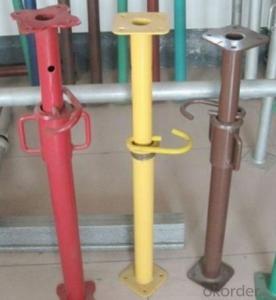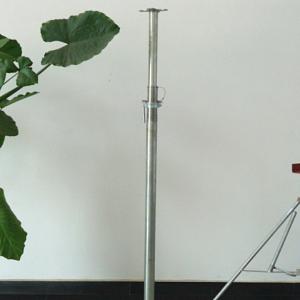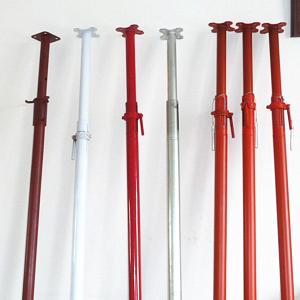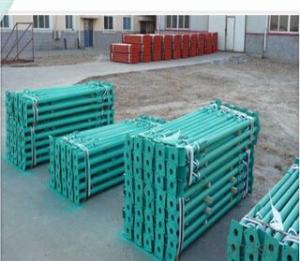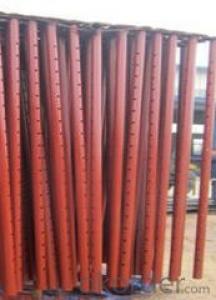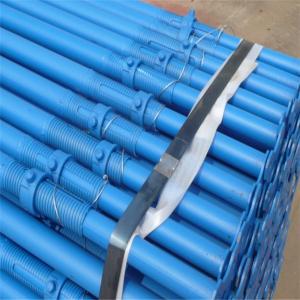adjustable Scaffolding Shoring Post props
- Loading Port:
- Tianjin
- Payment Terms:
- TT OR LC
- Min Order Qty:
- -
- Supply Capability:
- 180000 pc/month
OKorder Service Pledge
OKorder Financial Service
You Might Also Like
Product name: scaffolding prop
Type:italian ,German,Spanish,Middle East prop, steel pipe surpport.
Adjustable height:0.8-5.5m
Pipe/Tube tickness:1.5mm-4mm
Innner Diameter:40mm,48mm,etc.
Outer Diameter:48mm,56mm,60mm,etc.
Plate type:square,flower/clover,U-head
Nut type: single handle(common,7-style, big 7-style),Cup-style/Double handle
Pin type:line stright with metal cap,line straight without metal cap,chain,G-style
Plate size:120*12*4mm,120*120*5mm,140*140*5mm/5.5mm,etc.
Surface treatment: painted,galvanized,powder coating
Color:orange,red,blue,green,white,etc.
OEM ACCEPTABLE
Fast delivery wihtin 30days
Professional and reliable
- Q: What are the differences and similarities between the support of wood, steel, and steel?
- Wood support is used as a supporting component of wood, usually used for relatively small force and load structure; easy to draw materials, simple and convenient construction, low cost, should be used as a support.
- Q: How do you choose the right size of steel prop for a project?
- When choosing the right size of steel prop for a project, there are several factors to consider. Firstly, you need to evaluate the load-bearing capacity required for the project. This involves calculating the weight that the steel prop needs to support, including any additional loads that may be applied during construction. Next, you should consider the height of the prop. The height should be adjustable to accommodate the specific requirements of your project, ensuring that it can reach the desired height and provide adequate support throughout the construction process. Additionally, the diameter of the steel prop is crucial. Thicker diameters are generally recommended for heavier loads, while thinner ones may be suitable for lighter loads. It is essential to ensure that the diameter chosen can withstand the anticipated load without buckling or collapsing. Furthermore, the material used in the manufacturing of the steel prop should be considered. High-quality steel props are typically made from robust and durable materials that can withstand the demands of construction projects. It is advisable to opt for props made from materials such as high-strength steel to ensure long-lasting performance. Lastly, it is vital to consult engineering specifications and guidelines provided by manufacturers or industry standards. These guidelines offer a wealth of information regarding load capacities, height adjustments, and other technical details that can assist you in choosing the right size of steel prop for your project. In summary, selecting the right size of steel prop for a project requires evaluating the load-bearing capacity, height requirements, diameter, material quality, and consulting engineering specifications. By considering these factors, you can ensure that the steel props chosen are suitable for the project and provide the necessary support and stability throughout the construction process.
- Q: Are steel props suitable for use in earthquake-prone areas?
- Steel props are generally not suitable for use in earthquake-prone areas. While steel props may provide temporary support for construction or renovation projects, they are not designed to withstand the intense shaking and lateral forces that earthquakes generate. In earthquake-prone areas, it is essential to use specialized earthquake-resistant structural systems that can absorb and dissipate the energy released during seismic events. These systems are typically designed using materials and techniques such as reinforced concrete, structural steel frames, or base isolation technologies that can better withstand the dynamic forces and ground motion caused by earthquakes. Therefore, it is crucial to consult with structural engineers and adhere to local building codes and regulations to ensure the safety and resilience of structures in earthquake-prone areas.
- Q: What are the different surface treatments available for steel props?
- Steel props have various surface treatment options available, each with its own unique benefits and characteristics. Some of the most commonly used treatments for steel props are: 1. Hot-dip galvanizing: This method involves immersing the steel props in molten zinc, forming a protective layer that prevents rust and corrosion. Hot-dip galvanizing provides excellent durability and is ideal for outdoor use. 2. Powder coating: To apply powder coating, a dry powder is added to the steel props and then heated to create a strong and durable coating. This treatment offers a wide range of colors and finishes, enhances aesthetics, and provides protection against corrosion, chemicals, and UV rays. 3. Epoxy coating: Epoxy coating is a type of paint that contains epoxy resin, offering a resilient and long-lasting finish for steel props. It has excellent resistance to chemicals, abrasion, and corrosion, making it suitable for demanding industrial environments. 4. Paint coating: Painting steel props is a common surface treatment that allows for a variety of colors and finishes. However, it is generally less durable than other options and may require periodic maintenance or touch-ups to prevent corrosion. 5. Electroplating: Electroplating involves depositing a layer of metal, such as chrome or nickel, onto the steel props through an electrochemical process. This treatment enhances appearance and provides corrosion resistance, but it may not be as durable as other choices. 6. Anodizing: Although typically used for aluminum, anodizing can also be applied to steel props. It creates a thin protective oxide layer on the surface, improving corrosion resistance and offering various aesthetic options. The selection of a surface treatment depends on specific requirements such as intended use, environmental conditions, aesthetics, and budget. Seeking advice from professionals or suppliers can help determine the most suitable surface treatment for steel props in a particular application.
- Q: 7.5 square meters of toughened glass floor C steel support costs about how much
- Do not want to talk about the width of the beam, how to calculate the beam width of the cross section of the vertical spacing required?
- Q: Can steel props be used in seismic zones?
- Steel props can be used in seismic zones, but their use should be carefully evaluated and designed to ensure they can withstand the potential seismic forces. Steel props are commonly used in construction to support temporary structures or to provide additional support to existing structures during renovation or repair work. In seismic zones, where there is a higher risk of earthquakes, it is essential to consider the specific requirements and regulations related to seismic design. These requirements typically include factors such as the expected level of ground shaking, the building's location, the structural system, and the type of material used. Steel props can be designed to withstand seismic forces by considering factors such as their size, shape, material strength, and connection details. The design should take into account the expected seismic loads and incorporate appropriate safety factors to ensure the props can resist these forces without failure. In addition to proper design, it is also crucial to ensure that the installation and anchorage of steel props in seismic zones are carried out correctly. This may involve using specific techniques or additional reinforcement measures to enhance their stability and resistance to seismic forces. Ultimately, the use of steel props in seismic zones is possible, but it requires careful evaluation, design, and installation to ensure their effectiveness and safety. Consulting with structural engineers and adhering to local building codes and regulations is crucial to ensure that steel props are appropriately used in seismic-prone areas.
- Q: Are steel props reusable?
- Yes, steel props are generally reusable. Steel props, also known as adjustable steel props or steel shore, are temporary support structures used in construction projects to support and stabilize formwork, scaffolding, and other temporary structures. Steel props are designed to be adjustable in height, making them versatile and suitable for various applications. They are made from high-quality steel, which provides strength and durability. Steel props are typically painted or coated to prevent rust and corrosion, further enhancing their longevity. After use, steel props can be inspected for any damage or wear and tear. If they are in good condition, they can be cleaned, stored, and reused in future construction projects. Proper maintenance and regular inspections are key to ensuring the safety and performance of steel props when reusing them. However, it is essential to note that the reusability of steel props may depend on various factors, including the nature of the construction project, the load-bearing requirements, and the extent of wear and tear experienced during previous use. It is crucial to follow manufacturer guidelines, industry standards, and regulatory requirements to determine the suitability of steel props for reuse.
- Q: Can steel props be customized for specific projects?
- Yes, steel props can be customized for specific projects. Steel props are versatile and can be adjusted in height, width, and load-bearing capacity to meet the requirements of different construction projects. Customization allows for optimal support and stability, ensuring the safety and efficiency of the construction process.
- Q: Are steel props suitable for supporting temporary walkways or catwalks?
- Temporary walkways or catwalks can be effectively supported by steel props. These props, also referred to as scaffolding props, consist of adjustable steel tubes that are utilized for supporting various structures during construction or maintenance tasks. Their purpose is to ensure stability and the ability to bear loads, making them the perfect choice for temporary walkways or catwalks. There are numerous advantages associated with the use of steel props for this particular purpose. Primarily, they are incredibly easy to install and can be adjusted to the desired height, providing a stable platform for individuals to walk on. The adjustability feature allows for the props to be utilized in different heights and configurations, ensuring a level and safe walkway or catwalk. Moreover, steel props are renowned for their strength and durability. They possess the capability to withstand heavy loads and support the weight of multiple individuals simultaneously. This aspect renders them suitable for supporting temporary walkways or catwalks, where safety and stability are of utmost significance. Additionally, the versatility of steel props enables them to be used in various construction applications. They can be effortlessly combined with other scaffolding components to create a reliable and secure structure. This adaptability makes steel props a popular choice for temporary walkways or catwalks, as they can be customized to meet different requirements and site conditions. To summarize, steel props are indeed suitable for supporting temporary walkways or catwalks. Their adjustability, strength, and versatility make them an excellent option for establishing secure and stable platforms for individuals to utilize during construction or maintenance projects.
- Q: What are the different footplate options available for steel props?
- Steel props offer a range of footplate options to cater to different construction needs and site conditions. The first option is the Standard Footplate, which is widely used. It consists of a flat plate with holes for securing the prop to the ground using bolts or nails. This versatile footplate can be used on various surfaces like concrete, soil, or timber decking. For uneven ground or precise height adjustments, the Screw Jack Footplate is recommended. It incorporates a screw mechanism that allows for vertical adjustment of the prop height. This footplate ensures stability and is commonly used for supporting formwork or temporary structures. The U-Head Footplate features a U-shaped or V-shaped head on top, providing a secure resting point for beams or timber joists. It is suitable for applications that require additional support for horizontal loads, such as during the installation of horizontal formwork or supporting beams. The Spiked Footplate is ideal for soft or loose soil conditions. It has metal spikes or teeth on the underside that penetrate into the ground, providing added stability. This footplate is commonly used in outdoor construction projects or on uneven terrain. To protect sensitive or finished surfaces like tiled floors or polished concrete, the Rubber Footplate is recommended. It minimizes damage by providing a cushioning effect and distributing the load evenly, reducing the risk of indentation or surface marks. This footplate is commonly used in indoor construction projects or areas where floor protection is crucial. Selecting the appropriate footplate option depends on factors such as ground conditions, load-bearing capacity, and surface protection needs. Consulting with a structural engineer or specialized supplier can help determine the most suitable footplate option for steel props in any given situation.
Send your message to us
adjustable Scaffolding Shoring Post props
- Loading Port:
- Tianjin
- Payment Terms:
- TT OR LC
- Min Order Qty:
- -
- Supply Capability:
- 180000 pc/month
OKorder Service Pledge
OKorder Financial Service
Similar products
Hot products
Hot Searches
Related keywords

